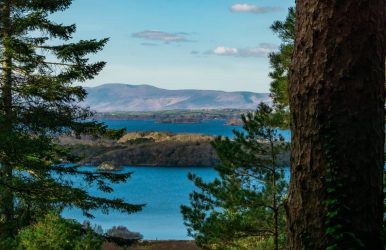Did You Know You can Hear Banshee’s Wail at the Killarney National Park!
BY Sibashree Sep 5, 2024
What is a national park to you? For me, it is a place that brings together nature, history, culture, and outdoor pursuits. Killarney National Park, which has been recently in the news for all the good reasons, is not an exception, for sure! Also, this national park in a 300-year-old town surely has many tales to tell. It is also related to Irish folklore, as you can hear “Banshee’s Wail” in this park. Moreover, it’s great that woodpeckers have started breeding in the national park for the first time in centuries, and the spotted chicks of woodpeckers look the cutest. Again, the release of four white-tailed eagle chicks in the national park grabbed much attention. Further, this is an endeavor to bring back the eagles, which were extinct in Ireland. In addition, there has been a renewed interest in the park among locals thanks to the 100th anniversary of the “Elizabeth Rose” in September 20241. This year, the Muckross Rowing Club and the Muckross Rowing Club Festival this year will celebrate the centenary of “Elizabeth Rose Killarney Six,” the first traditional racing boat to hit the Lakes of Killarney. So, with all the focus now on Killarney National Park, let’s try to learn more about it. Where Is The Killarney National Park? Killarney National Park, the first national park in Ireland, is in County Kerry, southwest Ireland. Killarney town is beside County Kerry. Further, with an extensive range of wildlife species, this park basks in exceptional ecological value. Moreover, spreading across 10,000 hectares, it has mountains, waterfalls, woodlands, and lakes. How To Reach Killarney National Park The cheapest way to reach Killarney National Park is to take a train to the Killarney railway station. Further, from the railway station, you must take just a 10-minute ride to the national park. The N71 road is the main access point to the national park. However, you can also reach the park by bus or car. Things You Cannot Miss At Killarney National Park Killarney National Park is incomparable with its wilderness, and a large part of this national park has been unperturbed for hundreds of years. It is also home to some rare species, like red deer. In fact, the red deer herb currently residing in Killarney National Park is the last herd in Ireland. Further, the national park has walking and hiking trails, such as the Dundag to Torc Path trail, Old Kenmare Road, and Mossy Woods. Moreover, you can climb the Mangerton and Purple mountains to explore a beautiful vista of the park and its surrounding areas. So, let’s discuss all the activities at Killarney National Park in detail. Exploring The Wildlife In Killarney National Park This UNESCO Biosphere Reserve (1981) is home to Reenadinna Woods and the hub of protected and rare flora. Moreover, it has many endangered and rare mammals, reptiles, and amphibian’s species. Plants, Animals, And Other Creatures In Killarney National Park Conserved Animals/Birds Red Deer Herd Irish Cuckoo, and Eagle Rare Species of Fauna Native Kerry Cattle Herd Caddisfly Northern Emerald Dragonfly Rare and Protected Flora St. Patrick’s Cabbage Mountain Sorrel Greater Butterwort Green Spleenwort, and Blue-eyed Grass Mammals Red Deer Wolves Irish Hare Otter Birds White-tailed Sea Eagle Barn Owl Kingfisher Woodpecker Amphibians Smooth Newt Reptiles Viviparous Lizard Other Fauna Kerry Slug Freshwater Pearl Mussel Marsh Fritillary Atlantic Salmon It is due to the vast presence of various plants and animals, Killarney National Park promotes responsible behaviors and activities during your outdoor pursuits. Further, you can visit the national park with dogs, but it is better to avoid bringing them to the park during breeding season. Hiking In Killarney National Park You will find many trails to cycle or walk in the national park. All the trails offer you the opportunity to explore the wildlife and unique geology of the national park. Here, I will briefly discuss three such hiking and walking trails, but there are plenty more. Ross Island Mining Trail How about visiting a 15th-century castle in its full architectural glory? The Ross Island mining trail will take you to Ross Castle. On this trail, you will also find the oldest known metal mine in Ireland. It is even the oldest in the entire Western Europe. This 3 Km trail will take you around 1.5 hours to complete, and it is the most favorite trail for history lovers. The encampments, ruins, and mines tell the stories of human lives and the economy of a bygone era. You will even get to see some rare flora on this trail. Knockreer Circular Walk As the name suggests, the trail is circular, taking you to almost all accessible parts of the national park. You can walk or cycle on this trail to encounter the endangered red deer and enjoy the beauty of the MacGillycuddy Reeks and Lough Leane. If you want to catch some refreshments, you will find Deenagh Lodge here. Some of the ascents in the hike are tricky, but the overall experience is wholesome, with good food and the company of nature. Muckross House to Torc Waterfall Lake Loop The Muckross House to Torc Waterfall Lake Loop trail is ideal for families. The trail is a little challenging. However, the panoramic vista of the Middle Lake and the view of the limestone cliffs make the effort worth it. You can continue hiking through the woods and then take the stone steps to reach the woods down. Further, from the woods, you will get to behold the Torc Waterfall. Also, this 18m high waterfall is quite powerful. An Encounter With History And Culture At The Killarney National Park Heritage Sites Killarney National Park has many heritage sites that tell the tales of human history and life. Further, a trip to the park is incomplete without exploring these places. Name Of The Heritage Sites Things To Know Muckross Abbey Graveyard It has modern and old Irish graveyards. Also, it has the graves of 17th and 18th-century Gaelic poets, such as Geoffrey O’Donoghue, Eoghan Rua O’Suilleabhain, and Aodhagan O’Rathaille. Further, you will see the graves of many chieftains in the graveyard. Killarney House and Gardens It is the main visitor center for the park. Further, Formal Pleasure Gardens in the Killarney Gardens is the “longest Irish Herbaceous Border.” Also, the 1870 red brick building was the main seat of the Kenmare estate. Ross Castle It is a tower house made in the 15th century with some myths attached to it. O'Donoghues Mór built the castle, and people still believe that O'Donoghues Mór still sleeps under the lake water. It is said that here you can hear Banshee’s Wail. * Muckross House and Gardens It is one of the most prominent stately homes in Ireland. Moreover, the Tudor-style architecture of the mansion speaks of the affluent lifestyle of landowners in the 19th century. Old Weir Bridge It is a stone-made twin-arch bridge. Derrycunnihy Church This Roman Catholic church dates back to the late 19th century. Further, you can see barn owls and Lesser Horseshoe Bats near this church. Brickeen Bridge It has a pointed arch structure, and it’s an 18th-century bridge. Innisfallen Island and Monastery The monastery here dates back to 640 AD when it was built by St.Finian the Leper. Further, it was a place of immersive prayer and meditation for monks. Moreover, “The Annals of Innisfallen,” written by monks here, are important accounts of Irish history. Along with these sites, Killarney National Park has another historic area called the “Ladies View.” This was Queen Victoria's favorite place. Also, she was in love with the scenic beauty of the area. *According to Irish folklore, Banshee is a spirit which appears as a woman and screams in a shrill voice. The appearance of Banshee is believed to bring the death summon for any of the family members. Visiting The Habitats Of The Killarney National Park As a UNESCO Biosphere Reserve, this national park is full of waterbodies like ponds, lakes, rivers, and waterfalls. Further, there are heaths, bogs, rock formations, and grassland. So, do you want a brief idea about the diverse habitats of the park? Then, check the table below. Habitats Highlights Yew Woodland Muckross Peninsula Reenadinna Wood and the Carboniferous reef and pavement of limestone Thick bryophytes blanket the limestone structures and especially the presence of “southern Atlantic liverwort Marchesinia mackaii used in labs Yew, Oak, Hazel, Alder, and Ash Trees Wet Broadleaved Woodland Carboniferous limestone structures near the lake Waterlogged landscape Blanket Bog Bog moss hummocks Crowberry, Heath Rush, and other species Dry Broadleaved Woodland Tomies Wood Glaisín na Marbh Woodland Tracks Upper Doogary Woodland Tracks Sessile Oak Trees Rowan Trees Birch Trees Heath Deer Grass Purple Moor Grass Tormentil Mixed Woodland Game Wood Rhododendron, Sycamore and Various Exclusive Species of Plants Portuguese Laurel Flowering Plants Grassland Rare Flora Species, such as Carnation Sedge, Creeping Bent, Marsh Violet, etc. Waterfalls, Rivers and Streams Muckross Lake Upper Lake Unique Invertebrate Species Drowned Vegetation Wetlands, Ponds And Lakes Devil’s Punch Bowl Along with these habitats, you will find commercially established conifer plantations in the national park. You will find them on the slopes of the Muckross or Torc Mountain. These plantations have Scot pines, European larches, Sitka spruce, and many other varieties. Does Killarney National Park Have Restaurants And Cafes? https://www.instagram.com/p/C7Q9NLpIr5w/ Yes, you can catch some quick bites and refreshments at Killarney National Park, which has quite a few restaurants and cafes. Further, each restaurant has a standout feature of its history or commitment to a special cause. So, let’s know the names, their locations, and specialties. Restaurant/Cafe Location And Operating Hours Specialties Muckross House Garden Restaurant Near Muckross House (“Adjacent to main car parks and entrance road”) Baked salmon Cajon-style chicken breast Rainbow trout and sea-fresh cod duo (Also, gluten-free options, including various salads, are available here.) Deenagh Lodge It stands opposite St. Mary’s Cathedral on Port Road. Apple tart with custard Coffee Sandwiches (It is operated by people with Down syndrome. Also, vegan and vegetarian options are available.) Dinis Cottage Dinis Island (Take the route via N71) Homemade scones Apple pie Fresh sandwiches (It is more than 200 years old. Moreover, it has a Victorian charm.) Ross Castle Garden Cafe Ross Castle Freshly ground barista coffee Cakes and pastries are also available. Lord Brandon’s Cottage Gap of Dunloe’s southern end Coffee and snacks (An open-air cafe) Along with the restaurants and cafes, there are also Muckross Traditional Farms where you will find delicious, sweet meat on these farms. Further, you can arrange picnics at this national park, provided you do not leave any trace behind. However, BBQing and lighting campfires are not allowed in Killarney National Park. Final Words Before You Set In For The Killarney National Park Exploring the natural bounty and history at Killarney National Park is easy and safe, thanks to the available family facilities and first aid and emergency services. Further, you can call 112 or 999 to avail yourself of emergency services. In addition, first-aid services are offered at Muckross House and Gardens and the Killarney National Park Visitor Centre. Also, there are public toilets in the park. Moreover, for the children, there are changing facilities and playgrounds. So, it does not matter whether you are a solo traveler or you are traveling with your family and friends. Moreover, Killarney National Park is the go-to destination for you to encounter one of the best bio reserves in the world, an account of human history, and the most fascinating landscapes. So, if you are planning a trip to Ireland in late spring or early autumn, don’t forget to include Killarney National Park in your itinerary. Moreover, we would love to hear from you about the experience in the comment section below. Also read Top 10 Most Popular Paraguay Food That You Must Try. Where To Stay Near Lassen Volcanic National Park? – Explore The Best Options. Joy Cho Death At Grand Teton National Park: How To Remain Safe While Hiking In This Beautiful Yet Dangerous Land.













